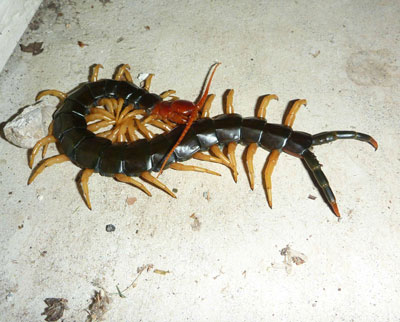We heard you wanted to see…
- Complaining about the Mainland - 17th August, 2024
- New island designation – is it just greenwash? - 26th April, 2024
- Police and Crime Commissioners – a solution or a problem? - 21st April, 2024
…a picture of a simply enormous centipede. So here it is.
This is Scolopendra heros, the aptly-named giant red-headed centipede. This one is in Austin, Texas, and was photographed very skilfully – and dare we say, courageously – by Reddit user DamnColorblindness. See his full-sized image here. You can get some idea of the size from the context, but this species is normally 16cm long, with some individuals up to 20cm long. That’s pretty big. And are they toxic to humans? They do bite, and the effect is unpleasant but not fatal or long-lasting. Of course some people are more susceptible than others. There is also an apocryphal alternative way in which this animal can poison humans. The University of Arkansas Arthropod Museum tells a great tale – obviously uncorroborated:
Scolopendra heros is purported to make tiny incisions with its legs while walking across human skin. When the animal is irritated, a poison is supposedly produced near the base of each leg and dropped into the wounds causing inflammation and irritation. According to one story an officer in the Confederate Army, while sleeping in his tent, was suddenly aroused by the creepy feeling of a large centipede crawling on his chest. A number of spots of deep red, forming a broad streak, indicated the arthropod’s passage across the man’s chest and abdomen. Violent pain and convulsions soon set in, accompanied by excessive swelling in the bitten area. The victim fought with death for two days and then succumbed. The agony suffered by the bitten officer was described by an eyewitness as the most frightful he had ever observed. The famed arthropod scientist J. L. Cloudsley-Thompson once explained that “centipedes seem to exert a weird fascination on the morbid appetites of the hysterical and insane.â€
This seems unlikely to me, as why would the centipede benefit from this expenditure of poison? How often, when attacked, would the creature actually be walking on its attacker? It seems a very inefficient way of defending oneself, or of pacifying prey. It’s certainly not impossible but I think I’m on the side of Cloudsley-Thompson.


Hello again! Missed you and Ruth and decided to drop back in.
…And to think that, until recently, I wanted to live in cool, hip Austin, TX! Well, in between the record heat, worst drought they’ve ever had, much higher property taxes than here and this awful-looking critter, I think I’m better off where I am!
Reminds me of my (brief) sojourn in Florida. The biggest cockroaches I’ve ever seen, some as long as my admittedly smallish hands, would reside in palmetto trees during the day and it was their mission to fly into the house at night. Gawd, those things were awful. But this centipede has the cockroaches beaten.
Thank you ever so much for saving me the trouble of moving to Austin!!! I’ll just be cool and hip here in Tiny Town.
“The first pair of limbs stretch forward from the body to cover the remainder of the mouth. These limbs, or maxillipeds, end in sharp claws and include venom glands that help the animal to kill or paralyse its prey.” – Wikipedia
I think someone at the University of Arkansas Arthropod Museum has an over-active imagination.
Although watching this BBC video ( http://www.youtube.com/watch?v=UROVfmY3NTA ), it’s easy to see why they’d think that. They do appear to hug their dinner partners… after snatching them out of the air. 🙂